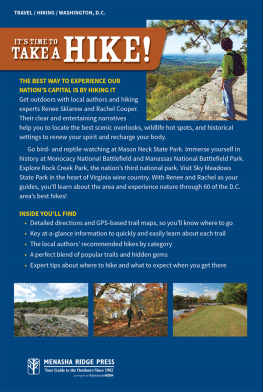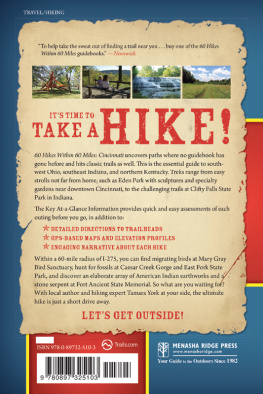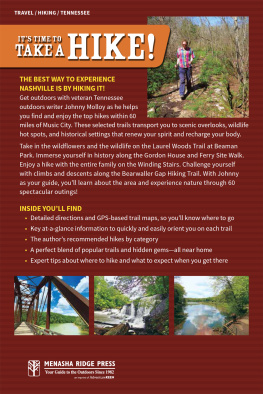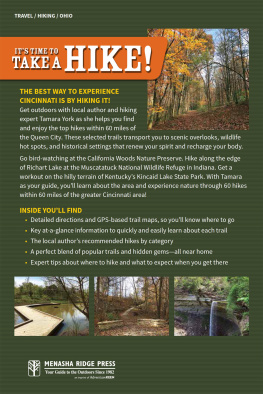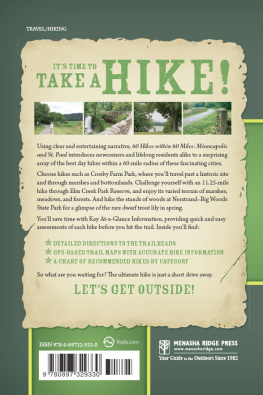
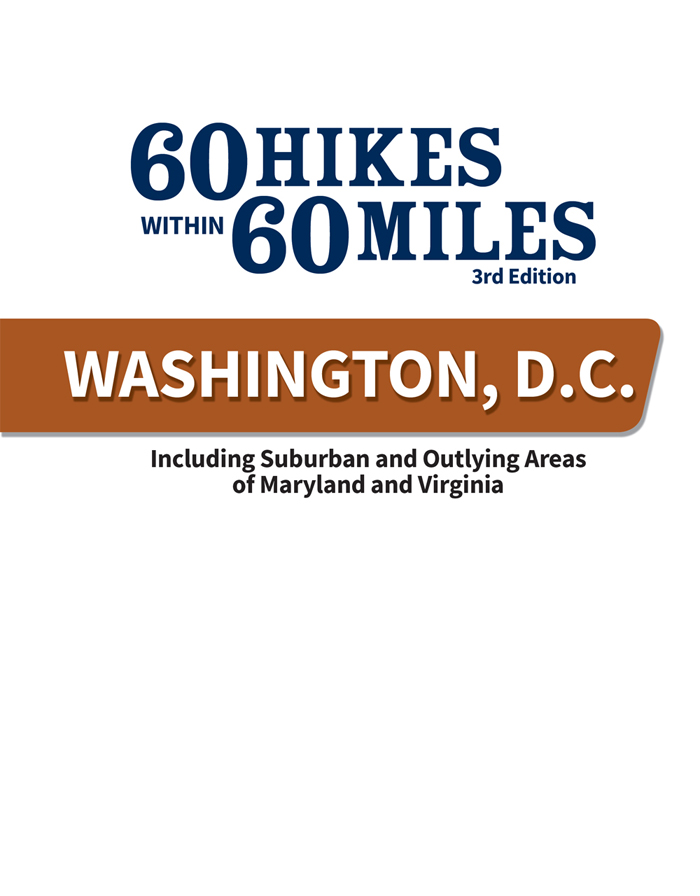
60 Hikes Within 60 Miles: Washington, D.C.
Copyright 2017 Renee Sklarew, Rachel Cooper, Brian Cooper, and Paul Elliott
All rights reserved
Printed in the United States of America
Published by Menasha Ridge Press
Distributed by Publishers Group West
Third edition, first printing
Cataloging-in-Publication Data is available from the Library of Congress.
LCCN 2017006841; ISBN 9781634040822 (pbk.); ISBN 9781634040839 (eISBN)
Cover and text design by Jonathan Norberg
Cover photo: Mason Neck Park Renee Sklarew
All other photos by Renee Sklarew, Eric Sklarew, Rachel Cooper, and Brian Cooper
Maps by Brian Cooper

MENASHA RIDGE PRESS
An imprint of AdventureKEEN
2204 First Ave. S, Ste. 102
Birmingham, AL 35233
Visit menasharidge.com for a complete listing of our books and for ordering information. Contact us at menasharidge.com, facebook.com/menasharidge, or twitter.com/menasha ridge with questions or comments. To find out more about who we are and what were doing, visit blog.menasharidge.com.
DISCLAIMER This book is meant only as a guide to select trails in the Washington, D.C., area and does not guarantee hiker safety in any wayyou hike at your own risk. Neither Menasha Ridge Press nor the authors of this book are liable for property loss or damage, personal injury, or death that result in any way from accessing or hiking the trails described in the following pages. Please be aware that hikers have been injured in the Washington area. Be especially cautious when walking on or near boulders, steep inclines, and drop-offs, and do not attempt to explore terrain that may be beyond your abilities. To help ensure an uneventful hike, please read carefully the introduction to this book, and perhaps get further safety information and guidance from other sources including the visitor centers or park representatives. Familiarize yourself thoroughly with the areas you intend to visit before venturing out. Ask questions, and prepare for the unforeseen. Familiarize yourself with current weather reports, maps of the area you intend to visit, and any relevant park regulations.

TABLE OF CONTENTS
ACKNOWLEGMENTS
We are grateful to Paul Elliott for creating the first two editions of this book. We understand that it is much beloved by many Washington, D.C.area hiking enthusiasts. Like Paul, we appreciate the assistance we received at the various parks and the expertise of many local guides and rangers.
While we included many of Pauls recommended hikes from previous editions, we decided to start almost completely fresh. We chose our own trails, made our own maps, and dropped and added parks for various reasons. In making our choices, we focused on appealing to a wide range of hikers, with options that range from easy to challenging, all of which can be accomplished on a day trip.
The most significant difference you will find are the new maps. Brian Cooper has profiled the trails we recorded with our Garmin eTrex units, which record elevations, distance, waypoints, and trailheads. Using the Garmin BaseCamp software application, Brian made sure every hike corresponds accurately with the narrative directions provided.
Before heading out on the trails, we relied on maps provided by the national, state, and local park services. We made sure to research where we were going and download any maps available to help us venture forth. Even with our park maps, there will be occasions when you will, like us, get a little lost or feel unsure about the turns you make. Out in the wild, some trails are not well marked and can be difficult to follow, but that is part of the adventure.
We hail the millions of volunteers who help maintain the parks, either with financial contributions or physical improvements, such as marking blazes, building structures that support the trail, and keeping the paths clear. Additional salutes go to the landscape shapers and environmental stewards, historians and visionaries, bloggers and hiking clubs that help introduce so many people to our treasured natural landscapes. They all have our collective thanks.
For the third edition, with its many new hikes and revised old ones, we wish to thank our intrepid family and friends who have been out on the trails with us, waiting patiently for us to document the waypoints, record directions, pose in pictures, and give us the moral support to finish this book. Special thanks go to Renees husband, Eric, who taught her about the native plants of this region. Thanks also to Scott McGrew for his work translating our GPS data into user-friendly maps. We also appreciate Tim Jackson for his trust in our ability to take on this challenging assignment; Kate Johnson for her sharp eyes, diligent editing skills and patient guidance; and to Menasha Ridge Press editor Holly Cross, who put all the pieces together to make it print-ready.
Renee Sklarew, Rachel Cooper, and Brian Cooper
FOREWORD
Welcome to Menasha Ridge Presss 60 Hikes Within 60 Miles, a series designed to provide hikers with information needed to find and hike the very best trails and other hiking routes in and around cities usually underserved by good guidebooks.
Our strategy is simple: First, find hikers who know the area and love to hike. And second, ask these people to spend a year hiking, mapping, photographing, and describing the very best hiking routes around in terms of difficulty, scenery, condition, elevation change, and all other categories of information that are important to hikers. On each hike, pretend you are a new hiker to the area and think about what any hiker would want to know, we tell each author. Imagine their questions; be clear in your answers.
Paul Elliott set the groundwork with first edition of this book. This is the third edition, the work of two hikers and a technology whiz who sought out hikes for all types of hikers. From urban hikes that make use of parklands and streets to flora-and fauna-rich treks along the Potomac River to aerobic outings in the mountains, this edition provides hikers (and walkers) with a great variety of hikesall within roughly 60 miles of D.C.
Youll get more out of this book if you take a moment to read the will help you choose an appropriate destination based on your specific interests and needs. The flora and fauna section provides an overview of the regions native wildlife and vegetation. And though this is a where-to, not a how-to, guide, those of you who have not hiked extensively will find the Introduction of particular value.
As much for the opportunity to free the mind as to free the body, let us direct you to hikes that elevate you above the urban commotion.
All the best,
The Editors at Menasha Ridge Press
A FEW WORDS ABOUT USING OUR MAPS
The maps in this book have been produced with care using the latest GPS receivers and Geographic Information System (GIS) software. When used with the hike descriptions, they will successfully direct you to the trailhead and keep you on course during the hike. However, because trail maintenance, new construction, storm or flood damage, and other factors can cause trails to change, we recommend consulting the online and/or physical resources referenced herein before venturing forth.
Next page
